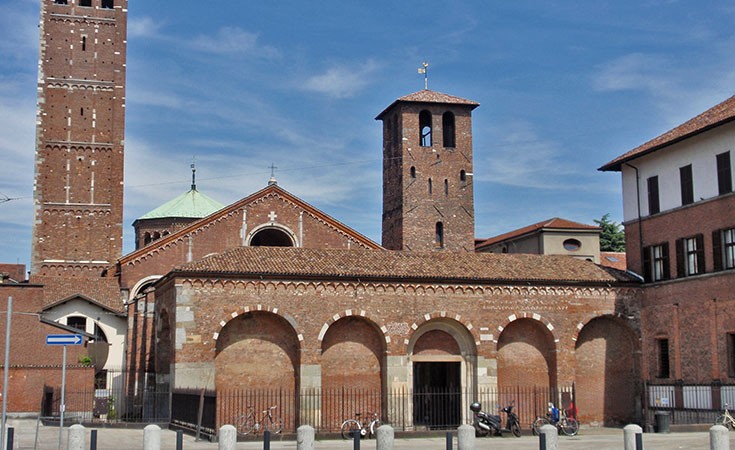Basilica of Sant’ Ambrogio or Saint Ambrose is a masterpiece of Romanesque architecture with the heritage sixteen centuries old. This basilica was commissioned by Bishop Ambrose and it is one of the oldest religious buildings in Milan. In this basilica one can still see the remains of the Saint Ambrose who died in the 4th century, whilst the Chapel of St Victor is very well known for the golden mosaics which date back to the beginning of the 6th century.
The Basilica was commissioned by Bishop Ambrose towards the end of the 4th century. It was constructed on an ancient graveyard, where according to a legend the bodies of Christians who were persecuted by the Roman Empire were buried Just after setting foot into the basilica, visitors may thoroughly enjoy intricately carved doors from the 4th and 7th century, on which the scenes from the Life of David and Saul (the first two kings of Israel) are depicted.
The Basilica assumed its final appearances between 1088 and 1099 during the last great reconstruction of the basilica. Even though the changes were radical, the three naves, three apses and quadrangle have been maintained. On both sides of the Basilica there are two towers dating back to different historical periods. The one to the right, called “Torre dei Monaci” (The Tower of the Monks), was built in the 8th century and was dedicated to the monks who lived in the church. The one to the left, called “Torre dei Canonici” (The Tower of the Canons), was built in the twelfth century. During the bombing in 1943, the Basilica was severely damaged, particularly the dome and mosaics behind the altar.
Conversely, the Chapel of St Victor with golden mosaics called the Golden Sky has withstood the passage of time. This chapel predates the basilica, since it was constructed at the graveyard first, while afterwards it was incorporated into the basilica itself. The golden mosaics date back to the beginning of the 5th century.
Interesting facts
- As the legend goes, the devil tried to put Saint Ambrose to temptation but ‘it’ was surprised that the man, instead of yielding to such a pressure actually took to even more profound prayers. The devil was so infuriated that ‘it’ rammed into the column at the entrance of Basilica with its own horns. If visitors decide to take a closer look at the column near the entrance to the church, they will be able to see the gaping holes made by the devil’s horns.
- The existence of two Towers in Basilica represents the division inside the church. The Monks’ Tower was built in the 8th century and used by the monks as a belfry, by means of which they called upon their congregation to the Mass. The canons (a different monastic order) did not have the possibility to use the Monks’ belfry and had to wait until the 12th century when their own was built.
- The original name of the church was Basilica Martyrum, because of the bodies of the martyrs who were buried close to the church. When the bishop Ambrose passed away and his body was laid to rest in the church, where it has been up to this day, the name of the church was changed into Basilica of Saint Ambrose.
- Saint Ambrose is the Saint and Protector of Milan and the Basilica is one of the main landmarks of the city.
- On a regular yearly basis, on December 7th there is a great celebration in honor of Saint Ambrose.
- When entering on the left side, the two painted boards symbolized the presence of the Templars at the time.
- Apart from being a burial place of Saint Ambrose, martyr Saint Gervasius and martyr Saint Potasisus, a high ranking Roman general Flavius Stilicho (during the reign of the Emperor Theodosius, Flavius was the most important personage in the Western Roman Empire) was also buried in this Basilica.
- The Serpent in bronze –visitors may see the sculpture in Basilica – the serpent was believed to be a gift from the Byzantine emperor Basil to the Basilica of Milan. The snake is a biblical symbol which stands for the personification of sin, but also the ancient symbol of knowledge and healing. Even today the Rod of Asclepius (a serpent-entwined rod) is used as a symbol of medicine.
Ticket prices for the basilica of Sant’ Ambrogio
The admission to the basilica is
free of charge.
2 € - The admission to the small museum of ancient artifacts and masterpieces made in the period from the 7th to the 18th century and the Chapel of St Victor of the Golden Sky.
Working hours of the basilica of Sant’ Ambrogio
From Tuesday to Sunday working hours of the basilica are
09:30-11:45h /
14:30-18:00h;
Working Hours of the museum: Tuesday – Sunday
10:00 – 12:00h and
14:30 – 17:30h;
Closed- all Mondays.

Translation support -
angloland

 Translation support - angloland
Translation support - angloland